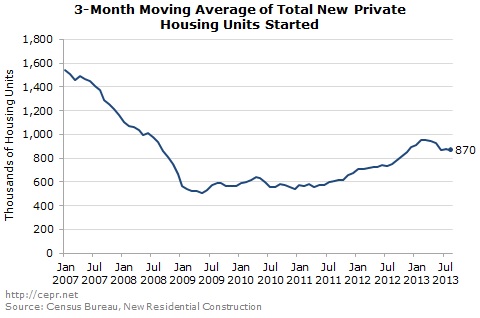September 24, 2013
September 24, 2013
By Dean Baker
The July Case-Shiller 20-City Index provided further evidence of a slowing housing market, rising by 0.6 percent for the month — the smallest increase since a 0.5 percent rise last September. Two of the cities, Minneapolis and Cleveland, showed price declines for the month. The weakening in the index is consistent with other data showing the market has slowed considerably in response to the recent jump in mortgage interest rates.
In this respect it is important to remember the Case-Shiller data is a lagging indicator. It is a three-month average that ends with the month for the survey. And the gap between a contract signing and a closed sale adds further to the delay. This means that the July data is just beginning to pick up the effect of the rise in interest rates that mostly took place in June.
Other more timely data reflect the impact of the rate increases more clearly. The Census Department’s report of a sharp 13.4 percent drop in new home sales in July provided a clear indication that higher interest rates were having a substantial effect. (New homes sales measure contracts signed in the month, not completed sales.) There is a similar story in housing starts. After rising sharply in 2012, starts peaked in March and have been pretty much flat in subsequent months. Residential construction may still contribute to growth in the second half of 2013 and 2014, but its impact is likely to be considerably less than in 2012 and the first half of this year.
Mortgage applications data are also consistent with a slowdown picture. After showing double-digit gains over 2012 levels earlier in the year, applications have been just slightly higher than 2012 levels in the last two months. The mortgage application index will miss any falloff associated with investors leaving the market, which is likely the major factor in the weakening of the market.
Despite the overall slowdown, most of the western cities in the Case-Shiller index again showed large price increases. Las Vegas led the way with a 2.5 percent jump. Prices in the city are now up 27.5 percent from their year-ago level and have risen at a 34.8 percent annual rate over the last three months. Prices in both Los Angeles and San Diego rose by 1.5 percent in July, while prices in San Francisco and Seattle rose by 1.3 percent.
Prices in all three California cities are up by more than 20 percent compared with year-ago levels, rising by 20.8 percent in Los Angeles, 20.4 percent in San Diego and 24.8 percent in San Francisco. Prices in these cities are close to three times their mid-1990s levels but are still more than 20 percent lower (in nominal dollars) than the peaks reached during the bubble.
The hot markets continue to be driven by sharp rises in the prices of homes in the bottom tier. In Las Vegas, the prices of homes in the bottom third of the market rose by 3.0 percent in July and is up 45.5 percent over the last year. In Los Angeles and San Diego, prices for homes in the bottom tier rose by 2.7 percent and 2.3 percent, respectively. Over the last year they have risen by 28.1 percent in Los Angeles and 26.0 percent in San Diego. Prices for homes in the bottom tier rose by 3.0 percent in San Francisco in July and are up 40.0 percent over the last year.
The cities already showing the slowest growth are also seeing this most clearly in the bottom tier. In Phoenix, where prices in the bottom tier rose by 43.4 percent between November of 2011 and November of 2012, prices for homes in the bottom tier rose by just 0.4 percent in July. Minneapolis had a 33.2 percent increase in prices for homes in the bottom tier between May of 2012 and May of 2013. Prices for homes in the bottom tier fell by 1.7 percent in July, their second consecutive decline.
On the whole, the data for the housing market should be seen as positive. The market is likely to see growth at a sustainable rate, but not experience another dangerous bubble.







